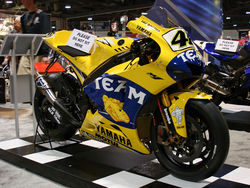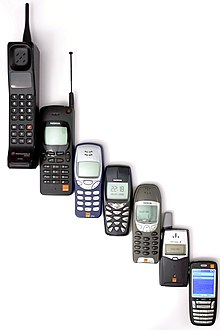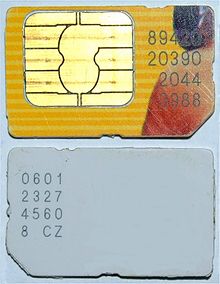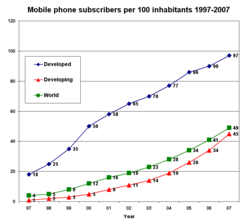Overview
A Road Racing World Championship Grand Prix was first organized by the Fédération Internationale de Motocyclisme (FIM) in 1949. The commercial rights are owned by Dorna Sports. Teams are represented by the International Road Racing Teams Association (IRTA) and manufacturers by the Motorcycle Sport Manufacturers Association (MSMA). Rules and changes to regulations are decided between the four entities, with Dorna casting a tie-breaking vote. In cases of technical modifications, the MSMA can unilaterally enact or veto changes by unanimous vote among its members.[1] These 4 entities compose the Grand Prix Commission.There have traditionally been several races at each event for various classes of motorcycles, based on engine size, and one class for sidecars. Classes for 50cc, 80cc, 125cc, 250cc, 350cc, and 500cc solo machines have existed over time, and 350cc and 500cc sidecars. Up through the 1950s and most of the 1960s, four-stroke engines dominated all classes. In part this was due to rules which allowed a multiplicity of cylinders (thus smaller pistons, thus higher revs) and a multiplicity of gears (thus narrower power bands, thus higher states of tune). In the 1960s, two-stroke engines began to take root in the smaller classes. In 1969 the FIM, citing high development costs for non-works teams, brought in new rules restricting all classes to six gears and most to two cylinders (four cylinders in the case of the 350cc and 500cc classes). This led to a mass walk-out of the sport by the previously highly successful Honda, Suzuki and Yamaha manufacturer teams, skewing the results tables for the next several years, with MV Agusta effectively the only works team left in the sport until Yamaha (1973) and Suzuki (1974) returned with new two-stroke designs. By this time, two-strokes completely eclipsed the four-strokes in all classes. In 1979, Honda on its return to GP racing made an attempt to return the four-stroke to the top class with the NR500, but this project failed, and in 1983, even Honda was winning with a two-stroke 500. The 50cc class was replaced by an 80cc class, then the class was dropped entirely in the 1990s, after being dominated primarily by Spanish and Italian makes. The 350cc class vanished in the 1980s. Sidecars were dropped from World Championship events in the 1990s (see Superside), reducing the field to 125s, 250s, and 500s.
MotoGP, the premier class of GP motorcycle racing, has changed dramatically in recent years. From the mid-1970s through 2001, the top class of GP racing allowed 500cc with a maximum of 4 cylinders, regardless of whether the engine was a two-stroke or four-stroke. Consequently, all machines were two-strokes, due to the greater power output for a given engine capacity. Some two- and three-cylinder two-stroke 500s were seen, but though they had a minimum-weight advantage under the rules, typically attained higher corner speed and could qualify well, they lacked the power of the four-cylinder machines. In 2002, rule changes were introduced to facilitate the phasing out of the two strokes, probably influenced by what was then seen as a lack of relevance: the last mass-produced 500cc 2-stroke model had not been available to the public for some 15 years.[original research?] The rules permitted manufacturers to choose between running two-strokes engines (500cc or less) or four-strokes (990cc or less). Manufacturers were also permitted to employ their choice of engine configuration. Despite the significantly increased costs involved in running the new four-stroke machinery, given their extra 490cc capacity advantage, the four-strokes were soon able to dominate their two-stroke rivals. As a result, by 2003 no two-stroke machines remained in the MotoGP field. The 125cc and 250cc classes still consist exclusively of two-stroke machines. In 2007, the MotoGP class had its maximum engine displacement capacity reduced to 800cc for a minimum of 5 years. For the 2012 season the capacity will be increased again to 1000cc.[2]
The 2008 racing calendar consisted of 18 rounds in 16 different countries (Spain which hosted 3 rounds, Qatar, Turkey, China, France, Italy, Great Britain, the Netherlands, Germany, Czech Republic, San Marino, Portugal, Japan, Australia and Malaysia). Exclusive to the MotoGP class, there was also a USA round at Mazda Raceway Laguna Seca in Monterey, California for the 800cc class only, this is because the paddock is not large enough to also include the other 2 classes. In 2008 a MotoGP event was held at the Indianapolis Motor Speedway for the first time on a newly prepared track, and observers noted that the Speedway had hosted motorcycle racing before cars raced there. All three classes were scheduled to race but severe wind and rain prevented the 250cc class from racing. MotoGP racing at Indianapolis is counterclockwise, with a new Snake Pit complex past the start-finish line before heading down the Turn 1 short chute and into the infield section.
The grid is composed of three columns (four for the 125cc and 250cc classes) and contains approximately 20 riders. Grid positions are decided in descending order of qualifying speed, the fastest on the 'pole' or first position. Races last approximately 45 minutes, each race a sprint from start to finish without pitting for fuel or tyres.
In 2005, a flag-to-flag rule for MotoGP was introduced. Previously, if a race started dry and rain fell, riders or officials could red-flag (stop) the race and either restart or resume on 'wet' tyres. Now, if rain falls a white flag is shown, indicating that riders can pit to swap the motorcycle on which they started the race for an identical one, as long as the tyres are different (that is, intermediates instead of wets, or slicks instead of wets)[1]. Besides different tyres, the wet-weather bikes have steel brake rotors and different brake pads instead of the carbon discs and pads used on the 'dry' bikes. This is because the carbon brakes need to be very hot to function properly, and the water cools them too much. The suspension is also 'softened' up somewhat for the wet weather.
When a rider crashes, track marshals wave a yellow flag, prohibiting passing in that area; one corner back, a stationary yellow flag is shown and passing in this area of the track is prohibited; if a fallen rider cannot be evacuated safely from the track, the race is red-flagged. Motorcycle crashes are usually one of two types: lowsides and the more dangerous highsides, though increased use of traction control has made highsides much less frequent.
According to one estimate, leasing a top-level motorcycle for a rider costs about 3 to 3.5 million dollars for a racing season.[3]
As a result of the 2008-2009 financial crisis, MotoGP is undergoing changes in an effort to cut costs. Among them are reducing Friday practice sessions; banning active suspension, launch control and ceramic composite brakes; extending the lifespan of engines; and reducing testing sessions.[4]
Chronology
- 1949: Start of the world championship in Grand Prix motorcycle racing.
- 1957: Gilera, Mondial and Moto Guzzi withdraw at the end of the season.
- 1958: MV Agusta win the constructor's and rider's championships in all 4 solo classes.
- 1959: MV Agusta retain all eight solo titles. Honda enter the Isle of Man TT for the first time.
- 1960: MV Agusta retain all 8 championships again.
- 1962: First year of 50cc class.
- 1966: Honda win the constructor's championship in all 5 solo classes.
- 1967: Final year of unrestricted numbers of cylinders and gears.
- 1968: Giacomo Agostini (MV Agusta) wins both 350cc and 500cc titles.
- 1969: As 1968.
- 1970: As 1968.
- 1971: As 1968.
- 1972: As 1968.
- 1972: Death of Gilberto Parlotti at the Isle of Man TT, leading ultimately to the loss of its championship status.
- 1973: Deaths of Jarno Saarinen and Renzo Pasolini at the Italian round at Monza.
- 1974: The Suzuki RG500 is the first square-4 in the 500cc class.
- 1977: The British Grand Prix moves from the Isle of Man TT to the British mainland.
- 1980: Patrick Pons (Yamaha 500cc) and Malcolm White (passenger Phil Love) (sidecar) were both killed in the British GP at Silverstone.
- 1982: The Yamaha OW61 YZR500 is the first V4 in the 500cc class.
- 1982: Jock Taylor (passenger Benga Johansson)(Windle-Yamaha) was killed at the Finnish sidecar GP. Imatra was subsequently removed from the GP calendar.
- 1984: Michelin introduces radial tyres in GPs.
- 1987: Push starts are eliminated.
- 1988: Wayne Rainey wins the first 500cc race using carbon brakes, at the British GP.
- 1988: Alfred Heck (passenger Andreas Räcke) was killed in during free practice in the French sidecar GP.
- 1989: Iván Palazzese (Aprilia) killed in 250cc German GP at Hockenheim.
- 1990: 500cc grid switches from 5 to 4 bikes per row.
- 1992: Honda introduces NSR500 with big bang engine.
- 1993: Shinichi Itoh and fuel-injected NSR500 break the 200 mph (320 km/h) barrier at the German GP at Hockenheim.
- 1993: Nobuyuki Wakai (Suzuki) killed during the practice session of the 250cc GP in Spain.
- 1994: Simon Prior, passenger of Yoshisada Kumagaya, on an LCR-ADM, was killed in a crash involving seven outfits in the Sidecar GP at Hockenheim.
- 1998: 500cc switch to unleaded fuel.
- 2002: MotoGP replaces 500cc class, allowing 990cc 4-strokes to race alongside 500cc 2-strokes.
- 2003: Daijiro Kato dies in first race of the season; Suzuka banned because of safety issues at 130R (there had been a serious Formula One crash at the 2002 Japanese Grand Prix in the same section).
- 2004: MotoGP grid switches from 4 to 3 bikes per row.
- 2004: Makoto Tamada earns Bridgestone their first MotoGP victory at the Brazilian GP.
- 2005: MotoGP adopts flag-to-flag rule, allowing riders to pit and switch to bikes fitted with wet- weather tyres and continue if rain begins to fall mid-race.
- 2007: MotoGP restricted to 800cc 4-strokes.
- 2008: Dunlop drops out of MotoGP.
- 2009: Michelin drops out of MotoGP and Bridgestone become sole tyre providers.[5][6]
- 2009: Kawasaki suspends MotoGP activities for 2009 and considers privateer team.
- 2010: Moto2 replaces 250cc class, allowing 600cc 4-strokes to race alongside 250cc 2-strokes.
- 2010: Moto2 rider Shoya Tomizawa killed in Misano.
- 2011: Moto2 restricted to 600cc 4-strokes.
- 2011: MotoGP Marco Simoncelli died in Sepang.[7]
- 2012: Moto3 250cc 4-stroke single cylinder class scheduled to replace the 125cc 2-stroke class.
- 2012: MotoGP scheduled to raise the maximum engine capacity to 1000cc.[8]
Tires
Tire selection is critical, usually done by the individual rider based on bike 'feel' during practice, qualifying and the pre-race warm-up laps on the morning of the race, as well as the predicted weather. The typical compromise is between grip and longevity—softer compound tires have more traction, but wear out more quickly; harder compound tires have less traction, but are more likely to last the entire race. Conserving rubber throughout a race is a specific talent winning riders acquire. Special 'Q' or qualifying tires of extreme softness and grip were typically used during grid-qualifying sessions until their use was discontinued at the end of the 2008 season, but they lasted typically no longer than one or two laps, though they could deliver higher qualifying speeds. In wet conditions, special tires ('wets') with full treads are used, but they suffer extreme wear if the track dries out.In 2007 new MotoGP regulations limited the number of tires any rider could use over the practice and qualifying period, and the race itself, to a maximum of 31 tires (14 fronts and 17 rears) per rider. This introduced a problem of tyre choice vs. weather (among other factors) that challenges riders and teams to optimize their performance on race day. This factor was greeted with varying degrees of enthusiasm by participants. Bridgestone had dominated in 2007 and Michelin riders Valentino Rossi, Nicky Hayden, Dani Pedrosa, and Colin Edwards all acknowledged shortcomings in Michelin's race tires relative to Bridgestone. Rossi, disappointed with and critical of the performance of his Michelin tires, switched to Bridgestones for 2008 and won the World Championship in dominant fashion. Pedrosa switched to Bridgestones during the 2008 season.
In 2008 the rules were amended to allow more tires per race weekend—18 fronts and 22 rears for a total of 40 tires. The lower number of tires per weekend was considered a handicap to Michelin riders. The only MotoGP team using Dunlops in 2007, Yamaha Tech 3, did not use them in 2008 but switched to Michelin.
For 2009, 2010 and 2011, a 'spec' tire supplier, Bridgestone, was appointed by the FIM (Michelin no longer supplying any tires to MotoGP). For the whole season Bridgestone provided 4 different specifications of front tire, 6 of rear, and a single wet specification—no qualifying specification. For each round Bridgestone provided only 2 specifications for front and rear. Tires will be assigned to riders randomly to assure impartiality.[9] Jorge Lorenzo has publicly supported the mono tyre rule.[10]
Riders
The premier class in the early 21st-century seasons was dominated by Italian Valentino Rossi, winner of the 2001-2005 and later the 2008 and 2009 titles. In an effort to beat Valentino's amazing consecutive victories on the 500-cc two-strokes and then the 990-cc four-stroke machines, other companies signed younger riders on newly designed 800-cc machines.
Specifications
The following shows the key specifications issues for each class. It was also introduced for the 2005 year, that under rule 2.10.5: 'No fuel on the motorcycle may be more than 15K below ambient temperature. The use of any device on the motorcycle to artificially decrease the temperature of the fuel below ambient temperature is forbidden. No motorcycle may include such a device.' This stops an artificial "boost" gained from increasing fuel density by cooling it.[edit] 125cc class

Moto3 class
The 125cc class will be replaced in 2012 by the Moto3 class. This class will be restricted to single cylinder 250cc 4-stroke engines with a maximum bore of 81 mm.[2]Moto2 class
Moto2 is the new 600cc 4-stroke class to replace 250cc 2-stroke class. Engines are produced by Honda;[11] tyres by Dunlop and electronics will be limited and supplied only by FIM sanctioned producers with max cost set at 650 EUR. Carbon-fibre brakes will be banned and only steel brakes will be allowed. However, there will be no chassis limitations. From 2010 onwards, only 600 cc four-stroke Moto2 machines are allowed.[12]MotoGP class
MotoGP is the 800cc class. The FIM has altered the specification for the class at several points in its history. At the beginning of the new MotoGP era in 2002, 500cc two-stroke or 990cc four-stroke bikes were specified to race. The enormous power advantage of the larger displacement four-stroke engine over the two-stroke eliminated all two-strokes from competition; the following season no two-stroke bikes were racing. In 2007 the maximum engine capacity was reduced to 800cc without reducing the existing weight restrictions.MotoGP-class motorcycles are not restricted to any specific engine configuration. However, the number of cylinders employed in the engine determines the motorcycle's permitted minimum weight; the weight of the extra cylinders acts as a form of handicap. This is necessary because, for a given capacity, an engine with more cylinders is capable of producing more power. If comparable bore to stroke ratios are employed, an engine with more cylinders will have a greater piston area and a shorter stroke. The increased piston area permits an increase in the total valve area, allowing more air and fuel to be drawn into the engine, and the shorter stroke permits higher revs at the same piston speed, allowing the engine to pump still more air and fuel with the potential to produce more power, but with more fuel consumption too. In 2004 motorcycles were entered with three-, four-and five-cylinder configurations. A six-cylinder engine was proposed by Blata, but it did not reach the MotoGP grids. Presently four cylinder engines appear to offer the best compromise between weight, power, and fuel consumption as all competitors in the 2009 series use this solution in either 'V' or in-line configuration.
In 2002, the FIM became concerned at the advances in design and engineering that resulted in higher speeds around the race track. For purposes of increasing safety, regulation changes related to weight, amount of available fuel and engine capacity were introduced. The amended rules reduced engine capacity to 800cc from 990cc and restricted the amount of available fuel for race distance from 26 litres in year 2004 to 21 litres in year 2007 and onwards. In addition, the minimum weight of 4 cylinder bike used by all participating teams was increased by 3 kg.
The highest speed for a MotoGP motorcycle in 125cc category is 249.76 km/h (155.193 mph) by Valentino Rossi in 1996 for Aprilia and the top speed in the history of MotoGP is 349.288 km/h (217.037 mph), set by Dani Pedrosa riding a Repsol Honda RC212V 800cc during Free Practice 1 at the 2009 Italian motorcycle Grand Prix.[13]
On December 11, 2009, the Grand Prix Commission announced that the MotoGP class would switch to the 1000 cc motor limit starting in the 2012 season. Maximum displacement will be limited to 1000 cc, maximum cylinders would be limited to 4, and maximum bore would be capped at 81 mm.[14] Carmelo Ezpeleta, the CEO of Dorna Sports indicated that the projected changes were received by the teams favorably.[15]
Weights
| Number of cylinders |
2002 Minimum | 2007 Minimum | 2010 Minimum |
|---|---|---|---|
| 2 | 135 kg (300 lb) | 137 kg (300 lb) | 135 kg (300 lb) |
| 3 | 135 kg (300 lb) | 140.5 kg (310 lb) | 142.5 kg (314 lb) |
| 4 | 145 kg (320 lb) | 148 kg (330 lb) | 150 kg (330 lb) |
| 5 | 145 kg (320 lb) | 155.5 kg (343 lb) | 157.5 kg (347 lb) |
| 6 | 155 kg (340 lb) | 163 kg (360 lb) | 165 kg (360 lb) |
- In 2005, fuel tank capacity was reduced by 2 litres to 24 litres
- In 2006, fuel tank capacity was reduced by a further 2 litres to 22 litres
- From 2007 onwards and for a minimum period of five years, FIM has regulated in MotoGP class that two-stroke bikes will no longer be allowed, and engines will be limited to 800cc four-strokes. The maximum fuel capacity will be 21 litres.
Engine Specifications
- Configuration: V2, V4 or Inline-4 (MotoGP class), Inline-4 (Moto2 class), 1-cylinder (125 cc class).
- Displacement: 800 cc (MotoGP class), 600 cc four-stroke (Moto2 class), 125 cc (125 cc class).
- Valves: 16-valve (MotoGP, Moto2), none (two-stroke engine) (125 cc).
- Valvetrain: DOHC, 4-valves per cylinder (MotoGP).
- Fuel: Unleaded (no control fuel) 100 Octane.
- Fuel Delivery: Fuel injection.
- Aspiration: Naturally aspirated engine.
- Power Output: 240 bhp (MotoGP class), >150 bhp (Moto2 class).
- Lubrication: Wet sump.
- Maximum Revs: 17500 - 18000 rpm.
- Max Speed: 217 mph / 349 km/h (MotoGP).
- Cooling: Single water pump.
Champions
The Riders' World Championship is awarded to the most successful rider over a season, as determined by a points system based on Grand Prix results.Giacomo Agostini is the most successful champion in Grand Prix history, with 15 titles to his name (8 in the 500cc class and 7 in the 350cc class). The most dominant rider of all time was Mike Hailwood, winning 10 out of 12 (83%) races, in the 250cc class, in the 1966 season. Mick Doohan, who won 12 out of 15 (80%) of the 500cc races in the 1997 Grand Prix motorcycle racing season also deserves an honourable mention. Valentino Rossi is the most successful contemporary rider, having won 9 titles including 6 Moto GP titles, and 1 each at 500cc, 250cc and 125cc levels. The current (2011) champion is Casey Stoner.
Scoring system
| Position | 1 | 2 | 3 | 4 | 5 | 6 | 7 | 8 | 9 | 10 | 11 | 12 | 13 | 14 | 15 |
|---|---|---|---|---|---|---|---|---|---|---|---|---|---|---|---|
| Points | 25 | 20 | 16 | 13 | 11 | 10 | 9 | 8 | 7 | 6 | 5 | 4 | 3 | 2 | 1 |











